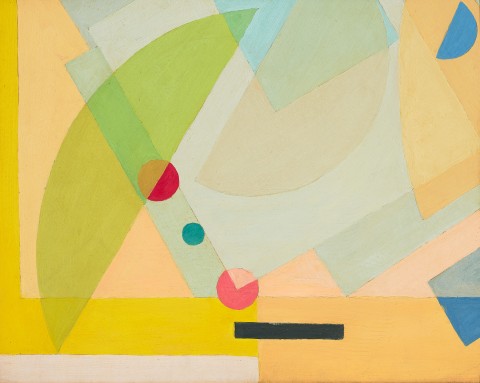CONSTRUCTIVE PAINTING, c.1942
RALPH BALSON
oil on card
48.0 x 60.0 cm
Private collection, Sydney
Lawsons, Sydney, c. 1969
Private collection, Sydney
Sotheby's, Melbourne, 4 May 2004, lot 146 (as 'Constructivist Painting')
Private collection, Sydney
Fine Australian Colonial, Impressionist, Edwardian and Modern Paintings and Prints, Scheding Berry Fine Art, Sydney, 13 – 21 December 1985 (illus. in exhibition catalogue)
There was never a time when Ralph Balson’s belief that abstraction was the highest form of expression ever diminished. He occasionally wrote about it, his art shifted from non-objective geometric paintings to become gestural and experimental. But critical to everything he produced was his disinterest in colloquial figuration – the landscape and nationalist heroism held no interest. He wanted Australian art to become international without any parochial facade.
Balson’s art is not an intellectual pursuit in itself, echoing those he admired, especially Mondrian. His association with Sydney’s burgeoning modernism shortly after he arrived from England in 1923 was critical. His enduring friendship with Grace Crowley became an arrangement of reciprocal understanding in each other’s pursuits, each exerting a profound effect upon the other. Their art became a marker of abstract art’s secure place in Australian art history.1
Crowley went to France and studied under Albert Gleizes and André Lhôte, where she responded to their reworking of Cubism. Back in Sydney in 1932 Crowley and Rah Fizelle established a School where Balson was a student. In 1939 he was included in Exhibition 1 at David Jones Gallery, the first exhibition in Australia of artists working with abstraction.
In Constructive Painting, c.1942, one finds a work which embraces a serious understanding of European geometric avant garde painting. The painting shares a close conceptual and pictorial system with the artist’s Construction in Green, 1942 (Art Gallery of New South Wales), also executed in oil on card. The overlapping and interlocking translucent forms in halftones surround more strongly defined shapes in red, blue and green – a black rectangle becomes a pictorial anchor. The irregularity becomes a resolved composition of sublime and elegant equilibrium.
The surfaces of Balson’s art are always important and the measured painterly personality in his geometric work is distinctive. Areas of subtle, lushly nuanced variations meet edges that hold the final distinct gesture of the brush. Soft irregular borders remind us that nothing is a conceptual template, that the presence of the artist’s hand is essential.
Balson can appear to us a precursor to many artists from the generation that followed him. Those who found purpose and certainty in geometric abstraction then moved to painterliness in various appearances, where each career signals a particular respect – David Aspden, Peter Booth and Michael Johnson are obvious examples. What they share in common is the depth of their introspection, rather than observation of an external world.
Balson’s autodidactic philosophical curiosities, especially scientific theory, increasingly shaped his thinking. He was born in Dorset in 1890, attended the local village school, left at age 13 and was apprenticed to a house painter and his formative instincts remained. Respect for Balson’s work has never ebbed, from his earliest work to his final Matter paintings he holds a critical presence in each decade of Australian art.
1. as witnessed by the recent exhibition, GRACE Crowley & Ralph Balson, held at The Ian Potter Centre: NGV Australia, Federation Square, Melbourne, 23 May – 22 September 2024.
DOUG HALL AM


